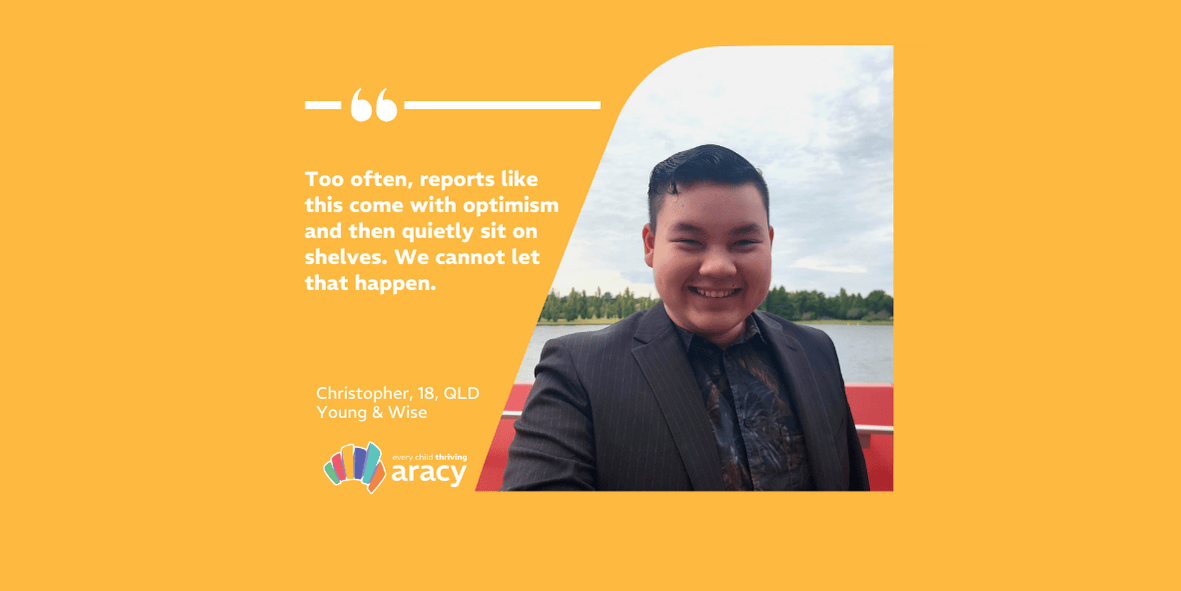
Hear from ARACY Board Chair Shamal Dass and Young and Wise member Christopher Hatano at the launch of The State of Australia’s Children Report.
The State of Australia’s Children Report isn’t just another report that trends for a week and disappears. For young people like me, it’s a mirror. A mirror that reflects our hopes, our struggles, and the lives we’re trying so hard to build. And while some parts of the report show progress, it also makes clear something many of us already know. Childhood in Australia isn’t always equal, and it isn’t always safe.
I’m 18, from a culturally diverse background, and reflecting on my life feels like living between the lines of this report. Growing up, money was becoming tighter. My parents worked long hours just to keep the lights on. For many that means being forced to step up early, just like being handed a backpack full of responsibilities before you’d even knew how to tie your shoes, but for me, it meant feeling I had to take initiative. I stopped playing sports to work part-time, had to deal with long bus routes that stretched across suburbs, and in some ways became another adult in the house before I turned 18.
There were nights when our home didn’t feel safe. Feeling secure should be as natural as breathing, yet it wasn’t. The report shows that safety and stability are not guaranteed for every child, and these aren’t just numbers. They are real lives, trembling under pressure, clinging to hope.
School wasn’t simple either. Arriving in Australia as a kid, English wasn’t my first language. I was determined to learn, but determination doesn’t stop the jokes about accents, the comments about skin colour, or the feeling of being the ‘odd-one-out’. Even in high school, managing a chronic condition meant navigating a different kind of judgment. The report reflects what so many young people share quietly. Discrimination based on culture, disability, gender, or difference chips away at your sense of belonging, and belonging is one of the things young people need most.
The growing conversation about social media bans adds another layer to what young people are already juggling. Adults often see online spaces as distractions or dangers, and yes, they can be. But for many of us, they are our communities, our playgrounds, and often the only place our voices truly matter, that’s why Technology, social media, and AI should be seen as tools, not distractions. How they affect us depends on how they’re used and whether young people are genuinely included in decisions about them.
Beyond that, young people carry what the report calls ‘adult worries’ – money, housing, and stability. Less than a third of Australian teens feel excited about the next five years, and that pressure isn’t abstract. I’ve felt it myself, supporting my parents while juggling schoolwork, thinking about rent while trying to study for exams. All of this takes a toll on mental health, which runs like an invisible thread through every choice and weighs on every decision. Some nights, deadlines, family responsibilities, and the quiet pressure to ‘just push through’ felt like carrying a backpack stuffed with bricks. For many, help is too far, too expensive, or not culturally safe. And sometimes the hardest part is simply not knowing who will truly understand.
The report doesn’t just point out problems, it points toward solutions that actually reflect what children experience every day. Early intervention is about stepping in before families hit crisis, so young people don’t have to carry adult worries like money, housing, or safety on their shoulders. A National Early Childhood Commission could bring all the scattered programs and policies into one place, making sure children aren’t lost in the gaps between services. Genuine co-design with young people isn’t about ticking a box, it’s about listening to those of us who live these realities, so decisions reflect what actually works in our communities. More mental health professionals in schools means support is available where we spend most of our time, not something we have to chase down. And a National Children’s Act isn’t just legal language, it’s a way to guarantee that children’s rights are protected and that leaders are accountable for keeping them safe and seen.
Too often, reports like this come with optimism and then quietly sit on shelves. We cannot let that happen. Millions of children’s stories, including mine, are woven into every data point. Even if some data isn’t completely current, the patterns are clear: without action, the struggles won’t stay the same – they will grow heavier.
Children aren’t asking for perfection. They’re asking to be seen. To be safe. To be heard.
And for change that lasts, not someday, but now. Behind every statistic is a young person trying their best in a world that often makes it harder than it should be. This report gives evidence, guidance, and hope. It’s up to us as a society, particularly those in leadership, to act and ensure every child can live fully, safely, and with hope for the future.
SHARE THIS

With six connected areas, The Nest ensures young Australians have everything they need for the best start in life, helping them reach their highest potential.

Using The Nest, has helped ARACY to be at the forefront of disease prevention and the promotion of holistic health for young Australians.

Here you’ll see some examples of how The Nest has been used in organisations outside of ARACY across Australia.